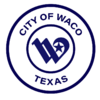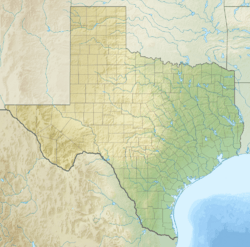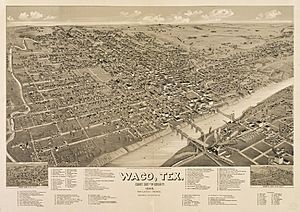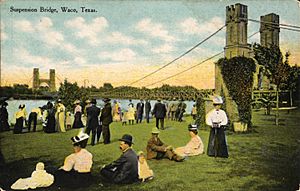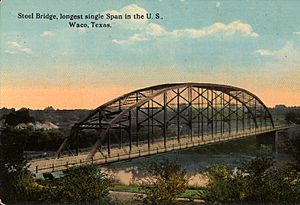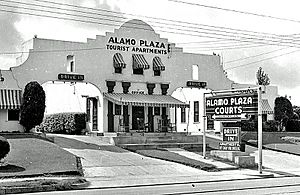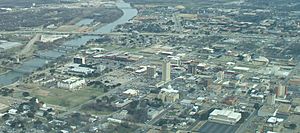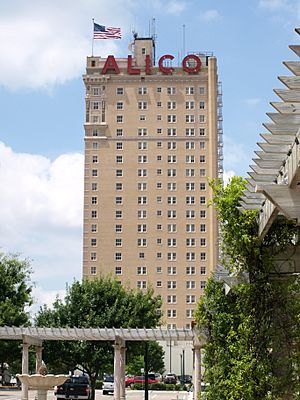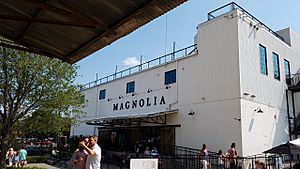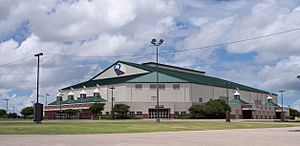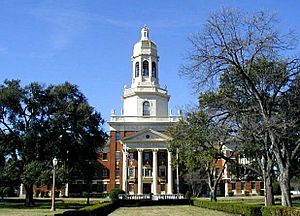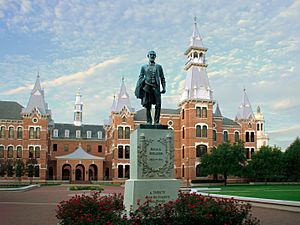Waco, Texas facts for kids
Quick facts for kids
Waco
|
|||||
|---|---|---|---|---|---|
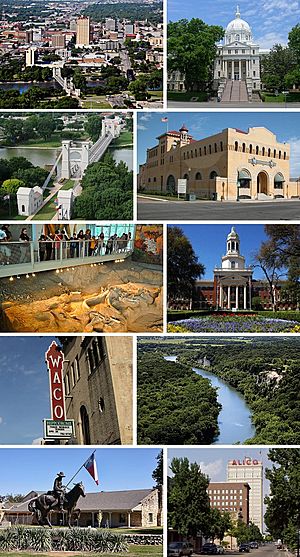
From left to right, top to bottom: Downtown, McLennan County Courthouse, Waco Suspension Bridge, Dr. Pepper Museum, Waco Mammoth National Monument, Baylor University, Waco Hippodrome, Cameron Park, Texas Ranger Hall of Fame and Museum, and Austin Avenue in Downtown
|
|||||
|
|||||
| Nickname(s):
"Heart of Texas"
"Buckle of the Bible Belt" |
|||||
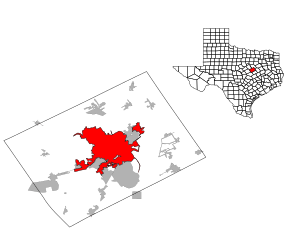
Location within McLennan County and Texas
|
|||||
| Country | United States | ||||
| State | Texas | ||||
| County | McLennan | ||||
| Named for | The Waco people | ||||
| Government | |||||
| • Type | Council–manager | ||||
| Area | |||||
| • City | 101.15 sq mi (261.98 km2) | ||||
| • Land | 88.73 sq mi (229.82 km2) | ||||
| • Water | 12.42 sq mi (32.16 km2) 11.85% | ||||
| Elevation | 522 ft (159 m) | ||||
| Population
(2020)
|
|||||
| • City | 138,486 | ||||
| • Estimate
(2023)
|
144,816 | ||||
| • Density | 1,569.16/sq mi (605.86/km2) | ||||
| • Urban | 192,844 (US: 201st) | ||||
| • Urban density | 2,145.6/sq mi (828.4/km2) | ||||
| • Metro | 304,865 (US: 168th) | ||||
| Demonym(s) | Wacoan | ||||
| GDP | |||||
| • Metro | .539 billion (2022) | ||||
| Time zone | UTC−6 (Central) | ||||
| • Summer (DST) | UTC−5 (Central) | ||||
| ZIP Codes |
76701-76708, 76710-76712, 76714-76716, 76797-76799
|
||||
| Area code | 254 | ||||
| FIPS code | 48-76000 | ||||
| GNIS feature ID | 2412162 | ||||
Waco (/ˈweɪkoʊ/ WAY-koh) is a city in McLennan County, Texas, United States. It is located along the Brazos River and I-35. Waco is about halfway between the cities of Dallas and Austin.
In 2023, the city had an estimated population of 144,816 people. This makes it the 24th-most populated city in Texas. The larger Waco area, which includes McLennan, Falls, and Bosque counties, had about 304,865 residents in 2023.
Contents
History of Waco
Early Days and Native Americans
For thousands of years, Indigenous peoples lived along the river in this area. The Wichita Native American tribe, known as the "Waco" (or Hueco in Spanish), lived where Waco is today.
In 1824, explorer Thomas M. Duke visited the area. He described the Waco village to Stephen F. Austin. Austin later made a peace treaty with the Waco people. The Waco tribe eventually moved north near Fort Worth. In 1872, they joined other Wichita tribes on a reservation in Oklahoma.
Building the City (1866–1900)
In 1866, the people of Waco decided to build a bridge over the wide Brazos River. They formed a company to build the Waco Suspension Bridge. It was finished in 1870 and was 475-foot (145 m) long. The bridge was important because cowboys and cattle herds on the Chisholm Trail used it to cross the river. This helped Waco grow quickly. Since 1971, the bridge has been only for people walking and is a historic site.
In 1885, the popular soft drink Dr Pepper was created in Waco at Morrison's Old Corner Drug Store.
Baylor University was founded in 1845 in another Texas town. It moved to Waco in 1886 and became a big part of the city. Another school, AddRan College, moved to Waco in 1895. It later changed its name to Texas Christian University (TCU) in 1902. TCU moved away from Waco in 1910 after its main building burned down.
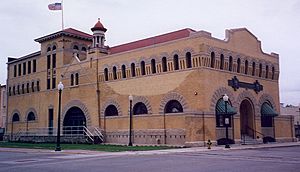
In the 1890s, Waco was known for its cotton industry. The first Cotton Palace fair and exhibition center was built in 1894 to celebrate this. The annual event attracted millions of visitors. The building was destroyed by fire and rebuilt in 1910. The fair ended in 1931 because of the Great Depression. However, the annual Cotton Palace Pageant still takes place today.
In 1896, a famous publicity stunt called "The Crash at Crush" happened near Waco. Two trains were intentionally crashed head-on by the Missouri–Kansas–Texas Railroad company. It was meant to be a fun event, but it turned dangerous when the train boilers exploded. Two people died, and several were hurt.
Waco in the 20th Century
In 1937, another famous soft drink, "Sun Tang Red Cream Soda," was created in Waco. It later became known as Big Red.
During World War II, Waco Army Air Field opened as a pilot training school. It was later renamed James Connally Air Force Base. The base closed in 1966. Today, it is home to Texas State Technical College and TSTC Waco Airport. This airport was used by Air Force One when former US President George W. Bush visited his ranch nearby.
On May 11, 1953, a powerful tornado hit downtown Waco. It killed 114 people. This tornado was one of the deadliest in U.S. history and helped lead to the creation of a national storm tracking system. A monument downtown remembers those who died.
In 1964, Waco became the home of the official museum for the famous Texas Rangers. It's now called the Texas Ranger Hall of Fame and Museum.
In 1978, ancient bones were found near the Brazos and Bosque Rivers. These bones were 68,000 years old and belonged to mammoths. The site, now called the Waco Mammoth National Monument, has the remains of at least 24 mammoths and other animals. It is a very important discovery.
In 1993, there was a serious event near Waco involving a group called the Branch Davidians. A standoff with government agents ended in a fire that destroyed their compound. Many people died in this event, known as the Waco siege.
Waco in the 21st Century
When George W. Bush was president, Waco was important because he had a ranch nearby. A special press center was set up in Waco for reporters when he visited his "Western White House."
Geography and Climate
Waco is located at 31°33'5" North, 97°9'21" West. The city covers about 95.5 square miles (247 km2), with about 11.85% of that area being water.
Waco has a humid subtropical climate. This means it has hot summers and usually mild winters. Temperatures can reach 90 °F (32 °C) in any month of the year. The highest temperature ever recorded was 112 °F (44 °C), and the lowest was −5 °F (−21 °C).
| Climate data for Waco, Texas (1981–2010 normals) | |||||||||||||
|---|---|---|---|---|---|---|---|---|---|---|---|---|---|
| Month | Jan | Feb | Mar | Apr | May | Jun | Jul | Aug | Sep | Oct | Nov | Dec | Year |
| Record high °F (°C) | 90 (32) |
96 (36) |
100 (38) |
101 (38) |
102 (39) |
109 (43) |
109 (43) |
112 (44) |
111 (44) |
101 (38) |
92 (33) |
91 (33) |
112 (44) |
| Mean daily maximum °F (°C) | 58.7 (14.8) |
62.3 (16.8) |
69.8 (21.0) |
78.1 (25.6) |
85.5 (29.7) |
92.2 (33.4) |
96.8 (36.0) |
97.3 (36.3) |
90.3 (32.4) |
80.4 (26.9) |
69.0 (20.6) |
59.5 (15.3) |
78.3 (25.7) |
| Mean daily minimum °F (°C) | 36.4 (2.4) |
40.0 (4.4) |
47.4 (8.6) |
54.9 (12.7) |
64.1 (17.8) |
71.1 (21.7) |
74.4 (23.6) |
74.1 (23.4) |
66.7 (19.3) |
56.9 (13.8) |
46.8 (8.2) |
37.7 (3.2) |
55.9 (13.3) |
| Record low °F (°C) | −5 (−21) |
4 (−16) |
15 (−9) |
26 (−3) |
35 (2) |
52 (11) |
58 (14) |
53 (12) |
39 (4) |
25 (−4) |
17 (−8) |
−4 (−20) |
−5 (−21) |
| Average precipitation inches (mm) | 2.12 (54) |
2.63 (67) |
3.15 (80) |
2.69 (68) |
4.29 (109) |
3.43 (87) |
1.79 (45) |
2.05 (52) |
3.04 (77) |
3.90 (99) |
2.82 (72) |
2.75 (70) |
34.66 (880) |
| Average precipitation days (≥ 0.01 in) | 7.1 | 6.8 | 8.3 | 6.3 | 8.1 | 7.5 | 5.3 | 5.0 | 5.8 | 7.2 | 7.3 | 7.1 | 81.8 |
| Source: NOAA | |||||||||||||
People of Waco
Waco is home to a diverse population. In 2020, there were 138,486 people living in the city. About 42.35% of the population was White (not Hispanic), 19.38% Black or African American (not Hispanic), and 31.67% Hispanic or Latino (of any race).
In 2000, about 25.4% of the people in Waco were under 18 years old. The average age was 28 years.
Economy and Jobs
Many people in Waco work for large organizations. Here are some of the top employers in the area:
| # | Employer | Employees 2023 |
|---|---|---|
| 1 | Baylor University | 3,253 |
| 2 | Ascension Providence | 3,075 |
| 3 | Waco Independent School District | 2,373 |
| 4 | H-E-B | 2,000 |
| 5 | Baylor Scott & White Health (Hillcrest) | 1,736 |
| 6 | Texas State Technical College | 1,706 |
| 7 | Veterans Affairs | 1,682 |
| 8 | City of Waco | 1,518 |
| 9 | Sanderson Farms, Inc. | 1,200 |
| 10 | Walmart | 1,174 |
Arts and Culture in Waco
Libraries and Museums
Waco has several libraries, including the Waco-McLennan County Library system. Baylor University has the Armstrong Browning Library, which holds collections of famous English poets.
There are many museums in Waco. These include the Dr Pepper Museum, the Texas Sports Hall of Fame, and the Texas Ranger Hall of Fame and Museum. The Waco Mammoth National Monument is a special museum where you can see ancient mammoth fossils.
Fun Places to Visit
Waco has many attractions for visitors. You can visit Hawaiian Falls water park or the Waco Suspension Bridge. Indian Spring Park is where the town of Waco first began. The Doris Miller Memorial honors a brave African American Navy hero from Waco.
The Waco Mammoth National Monument is a unique site. It has the fossils of 24 Columbian mammoths and other ancient animals. It's a great place to learn about prehistoric life.
Downtown Waco is home to Magnolia Market. This is a shopping area with stores, food trucks, and event spaces. It was created by Chip and Joanna Gaines from the TV show Fixer Upper.
Sports in Waco
The Baylor Bears sports teams play in Waco. Their football team has won many conference titles. The women's basketball team won the national championship in 2005, 2012, and 2019. The men's basketball team won the national championship in 2021.
Waco has also been home to professional baseball teams in the past. The city had teams like the Waco Tigers, Navigators, Steers, and Indians. In 1930, Waco's Katy Park hosted the first night game in Texas League history. A player named Gene Rye even hit three home runs in one inning!
Waco has several golf courses, including Cottonwood Creek Golf Course. In 2018, the IronMan 70.3 Waco triathlon event started in the city.
Parks and Outdoor Fun
Waco has a seven-mile scenic riverwalk along the Brazos River. It's a great place for walking and jogging. The path goes under the Waco Suspension Bridge. Lake Waco is a large lake on the western side of the city.
Cameron Park is a huge 416-acre (168 ha) park. It has playgrounds, picnic areas, and a disc golf course. In 2009, its trails were named a National Recreation Trail. The park also has the Cameron Park Zoo, which is 52-acre (21 ha) large.
Education in Waco
Most of Waco is served by the Waco Independent School District. Other parts of the city are in different school districts like Midway ISD. Waco has three large public high schools: Waco High School, University High School, and Midway High School.
There are also several charter and private schools in Waco.
Waco is home to three colleges:
- Baylor University
- McLennan Community College
- Texas State Technical College
In the past, other colleges were in Waco, including AddRan Male & Female College, which later became Texas Christian University.
Media in Waco
The main daily newspaper in Waco is the Waco Tribune-Herald. There are also several other local publications.
Waco has many television and radio stations. Some TV stations include KCEN (NBC), KWTX (CBS), and KXXV (ABC). Radio stations offer different types of music and talk shows, like Country, Pop, Rock, and News Talk.
Getting Around Waco
Transportation
Interstate 35 is the main highway that runs north and south through Waco. It connects Waco to major cities like Dallas, Fort Worth, Austin, and San Antonio. Texas State Highway 6 and US Highway 84 are other important roads.
Waco was home to the first traffic circle in Texas, built in 1933. It was designed to help traffic flow smoothly.
The Waco area has three airports. Waco Regional Airport (ACT) has daily flights to Dallas/Fort Worth International. TSTC Waco Airport (CNW) was used by former President George W. Bush. McGregor Executive Airport (PWG) is for smaller planes.
The Waco Transit System provides bus service around the city. You can also catch an Amtrak passenger train in nearby McGregor.
Famous People from Waco
Many notable people have connections to Waco.
Sports Stars
- Lee Ballanfant, a Major League Baseball umpire.
- Perrish Cox, a former NFL cornerback.
- Zach Duke, a former Major League Baseball pitcher.
- Derrick Johnson, a former NFL linebacker.
- Michael Johnson, a famous Olympic sprinter who graduated from Baylor University.
- LaDainian Tomlinson, a former NFL football player.
Baseball Players from Waco
- Lance Berkman, a well-known Major League Baseball player.
- Al Jackson, a Major League Baseball pitcher.
- Arthur Rhodes, a Major League Baseball pitcher.
- Schoolboy Rowe, a Major League Baseball pitcher.
Movie and TV Personalities
- Jules Bledsoe, a stage and screen actor and singer.
- Shannon Elizabeth, an actress from American Pie.
- Chip and Joanna Gaines, home renovators famous for their TV show Fixer Upper. They have helped boost tourism in Waco.
- Jennifer Love Hewitt, an actress.
- Steve Martin, a famous comedian, actor, and musician.
- Kevin Reynolds, a film director.
Music Artists
- Wade Bowen, a Texas country music artist.
- David Crowder Band, a Christian worship band from Waco.
- Pat Green, a country music singer-songwriter.
- Roy Hargrove, a Grammy Award-winning jazz trumpeter.
- Kari Jobe, a Christian singer-songwriter.
- Willie Nelson, a country music legend born nearby.
- Jessica Simpson, a pop music singer.
- Hank Thompson, a Country Music Hall of Fame member.
Other Notable People
- Shawn Achor, a best-selling author.
- T. Berry Brazelton, a pediatrician and author.
- Heloise, known for her "Hints from Heloise" advice column.
- Allene Jeanes, a chemical engineer who developed important substances.
- Doris (Dorie) Miller, an African American Navy hero during the attack on Pearl Harbor. He was awarded the Navy Cross.
- C. Wright Mills, a sociologist and author.
- Robert Wilson, a stage director.
- Ben Christie, also known as Uncle Ben, from the Urban Rescue Ranch on YouTube.
See also
 In Spanish: Waco para niños
In Spanish: Waco para niños



